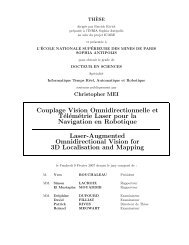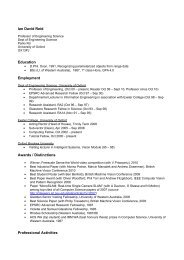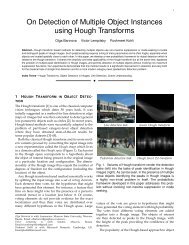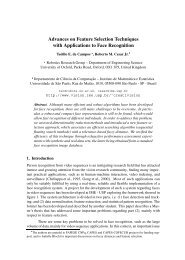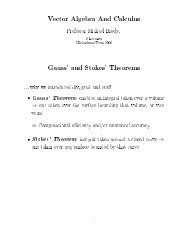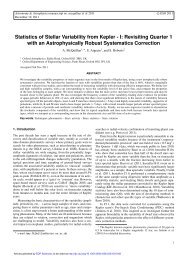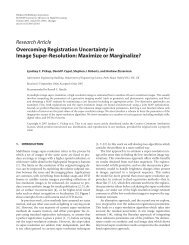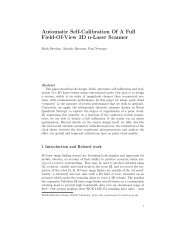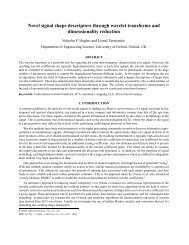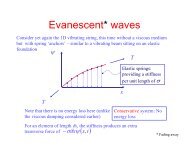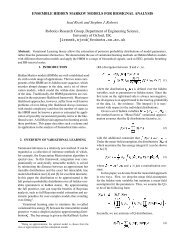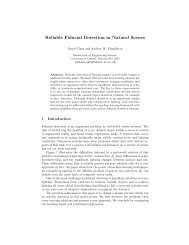Physiological Basis of the Electrocardiogram
Physiological Basis of the Electrocardiogram
Physiological Basis of the Electrocardiogram
Create successful ePaper yourself
Turn your PDF publications into a flip-book with our unique Google optimized e-Paper software.
CHAPTER 1<br />
The <strong>Physiological</strong> <strong>Basis</strong> <strong>of</strong> <strong>the</strong><br />
<strong>Electrocardiogram</strong><br />
Andrew T. Reisner, Gari D. Clifford, and Roger G. Mark<br />
Before attempting any signal processing <strong>of</strong> <strong>the</strong> electrocardiogram it is important<br />
to first understand <strong>the</strong> physiological basis <strong>of</strong> <strong>the</strong> ECG, to review measurement<br />
conventions <strong>of</strong> <strong>the</strong> standard ECG, and to review how a clinician uses <strong>the</strong> ECG<br />
for patient care. The material and figures in this chapter are taken from [1, 2], to<br />
which <strong>the</strong> reader is referred for a more detailed overview <strong>of</strong> this subject. Fur<strong>the</strong>r<br />
information can also be found in <strong>the</strong> reading list given at <strong>the</strong> end <strong>of</strong> this chapter.<br />
The heart is comprised <strong>of</strong> muscle (myocardium) that is rhythmically driven to<br />
contract and hence drive <strong>the</strong> circulation <strong>of</strong> blood throughout <strong>the</strong> body. Before every<br />
normal heartbeat, or systole, 1 a wave <strong>of</strong> electrical current passes through <strong>the</strong> entire<br />
heart, which triggers myocardial contraction. The pattern <strong>of</strong> electrical propagation<br />
is not random, but spreads over <strong>the</strong> structure <strong>of</strong> <strong>the</strong> heart in a coordinated pattern<br />
which leads to an effective, coordinated systole. This results in a measurable change<br />
in potential difference on <strong>the</strong> body surface <strong>of</strong> <strong>the</strong> subject. The resultant amplified<br />
(and filtered) signal is known as an electrocardiogram (ECG, or sometimes EKG).<br />
A broad number <strong>of</strong> factors affect <strong>the</strong> ECG, including abnormalities <strong>of</strong> cardiac conducting<br />
fibers, metabolic abnormalities (including a lack <strong>of</strong> oxygen, or ischemia)<br />
<strong>of</strong> <strong>the</strong> myocardium, and macroscopic abnormalities <strong>of</strong> <strong>the</strong> normal geometry <strong>of</strong> <strong>the</strong><br />
heart. ECG analysis is a routine part <strong>of</strong> any complete medical evaluation, due to <strong>the</strong><br />
heart’s essential role in human health and disease, and <strong>the</strong> relative ease <strong>of</strong> recording<br />
and analyzing <strong>the</strong> ECG in a noninvasive manner.<br />
Understanding <strong>the</strong> basis <strong>of</strong> a normal ECG requires appreciation <strong>of</strong> four phenomena:<br />
<strong>the</strong> electrophysiology <strong>of</strong> a single cell, how <strong>the</strong> wave <strong>of</strong> electrical current<br />
propagates through myocardium, <strong>the</strong> physiology <strong>of</strong> <strong>the</strong> specific structures <strong>of</strong> <strong>the</strong><br />
heart through which <strong>the</strong> electrical wave travels, and last how that leads to a measurable<br />
signal on <strong>the</strong> surface <strong>of</strong> <strong>the</strong> body, producing <strong>the</strong> normal ECG.<br />
1.1 Cellular Processes That Underlie <strong>the</strong> ECG<br />
Each mechanical heartbeat is triggered by an action potential which originates from<br />
a rhythmic pacemaker within <strong>the</strong> heart and is conducted rapidly throughout <strong>the</strong> organ<br />
to produce a coordinated contraction. As with o<strong>the</strong>r electrically active tissues<br />
1. Diastole, <strong>the</strong> opposite <strong>of</strong> systole, is defined to be <strong>the</strong> period <strong>of</strong> relaxation and expansion <strong>of</strong> <strong>the</strong> heart<br />
chambers between two contractions, when <strong>the</strong> heart fills with blood.<br />
1
2 The <strong>Physiological</strong> <strong>Basis</strong> <strong>of</strong> <strong>the</strong> <strong>Electrocardiogram</strong><br />
Figure 1.1 A typical action potential from a ventricular myocardial cell. Phases 0 through 4 are<br />
marked. (From: [2]. c○ 2004 MIT OCW. Reprinted with permission.)<br />
(e.g., nerves and skeletal muscle), <strong>the</strong> myocardial cell at rest has a typical transmembrane<br />
potential, V m, <strong>of</strong> about −80 to −90 mV with respect to surrounding<br />
extracellular fluid. 2 The cell membrane controls permeability to a number <strong>of</strong> ions,<br />
including sodium, potassium, calcium, and chloride. These ions pass across <strong>the</strong><br />
membrane through specific ion channels that can open (become activated) and<br />
close (become inactivated). These channels are <strong>the</strong>refore said to be gated channels<br />
and <strong>the</strong>ir opening and closing can occur in response to voltage changes (voltage<br />
gated channels) or through <strong>the</strong> activation <strong>of</strong> receptors (receptor gated channels).<br />
The variation <strong>of</strong> membrane conductance due to <strong>the</strong> opening and closing <strong>of</strong> ion<br />
channels generates changes in <strong>the</strong> transmembrane (action) potential over time. The<br />
time course <strong>of</strong> this potential as it depolarizes and repolarizes is illustrated for a ventricular<br />
cell in Figure 1.1, with <strong>the</strong> five conventional phases (0 through 4) marked.<br />
When cardiac cells are depolarized to a threshold voltage <strong>of</strong> about −70 mV (e.g.,<br />
by ano<strong>the</strong>r conducted action potential), <strong>the</strong>re is a rapid depolarization (phase 0 —<br />
<strong>the</strong> rapid upstroke <strong>of</strong> <strong>the</strong> action potential) that is caused by a transient increase<br />
in fast sodium channel conductance. Phase 1 represents an initial repolarization<br />
that is caused by <strong>the</strong> opening <strong>of</strong> a potassium channel. During phase 2 <strong>the</strong>re is an<br />
approximate balance between inward-going calcium current and outward-going<br />
potassium current, causing a plateau in <strong>the</strong> action potential and a delay in repolarization.<br />
This inward calcium movement is through long-lasting calcium channels<br />
that open up when <strong>the</strong> membrane potential depolarizes to about −40 mV. Repolarization<br />
(phase 3) is a complex process and several mechanisms are thought to<br />
be important. The potassium conductance increases, tending to repolarize <strong>the</strong> cell<br />
via a potassium-mediated outward current. In addition, <strong>the</strong>re is a time-dependent<br />
2. Cardiac potentials may be recorded by means <strong>of</strong> microelectrodes.
1.1 Cellular Processes That Underlie <strong>the</strong> ECG 3<br />
decrease in calcium conductivity which also contributes to cellular repolarization.<br />
Phase 4, <strong>the</strong> resting condition, is characterized by open potassium channels and <strong>the</strong><br />
negative transmembrane potential. After phase 0, <strong>the</strong>re are a parallel set <strong>of</strong> cellular<br />
and molecular processes known as excitation-contraction coupling: <strong>the</strong> cell’s depolarization<br />
leads to high intracellular calcium concentrations, which in turn unlocks<br />
<strong>the</strong> energy-dependent contraction apparatus <strong>of</strong> <strong>the</strong> cell (through a conformational<br />
change <strong>of</strong> <strong>the</strong> troponin protein complex).<br />
Before <strong>the</strong> action potential is propagated, it must be initiated by pacemakers,<br />
cardiac cells that possess <strong>the</strong> property <strong>of</strong> automaticity. That is, <strong>the</strong>y have <strong>the</strong> ability<br />
to spontaneously depolarize, and so function as pacemaker cells for <strong>the</strong> rest <strong>of</strong> <strong>the</strong><br />
heart. Such cells are found in <strong>the</strong> sino-atrial node (SA node), in <strong>the</strong> atrio-ventricular<br />
node (AV node) and in certain specialized conduction systems within <strong>the</strong> atria and<br />
ventricles. 3 In automatic cells, <strong>the</strong> resting (phase 4) potential is not stable, but shows<br />
spontaneous depolarization: its transmembrane potential slowly increases toward<br />
zero due to a trickle <strong>of</strong> sodium and calcium ions entering through <strong>the</strong> pacemaker<br />
cell’s specialized ion channels. When <strong>the</strong> cell’s potential reaches a threshold level,<br />
<strong>the</strong> cell develops an action potential, similar to <strong>the</strong> phase 0 described above, but<br />
mediated by calcium exchange at a much slower rate. Following <strong>the</strong> action potential,<br />
<strong>the</strong> membrane potential returns to <strong>the</strong> resting level and <strong>the</strong> cycle repeats. There are<br />
graded levels <strong>of</strong> automaticity in <strong>the</strong> heart. The intrinsic rate <strong>of</strong> <strong>the</strong> SA node is<br />
highest (about 60 to 100 beats per minute), followed by <strong>the</strong> AV node (about 40 to<br />
50 beats per minute), <strong>the</strong>n <strong>the</strong> ventricular muscle (about 20 to 40 beats per minute).<br />
Under normal operating conditions, <strong>the</strong> SA node determines heart rate, <strong>the</strong> lower<br />
pacemakers being reset during each cardiac cycle. However, in some pathologic<br />
circumstances, <strong>the</strong> rate <strong>of</strong> lower pacemakers can exceed that <strong>of</strong> <strong>the</strong> SA node, and<br />
<strong>the</strong>n <strong>the</strong> lower pacemakers determine overall heart rate. 4<br />
An action potential, once initiated in a cardiac cell, will propagate along <strong>the</strong><br />
cell membrane until <strong>the</strong> entire cell is depolarized. Myocardial cells have <strong>the</strong> unique<br />
property <strong>of</strong> transmitting action potentials from one cell to adjacent cells by means <strong>of</strong><br />
direct current spread (without electrochemical synapses). In fact, until about 1954<br />
<strong>the</strong>re was almost general agreement that <strong>the</strong> myocardium was an actual syncytium<br />
without separate cell boundaries. But <strong>the</strong> electron microscope identified definite cell<br />
membranes, showing that adjacent cells separate. They are tightly coupled, however,<br />
to transmit both tension and electric current from cell to cell. The low-resistance<br />
connections are known as gap junctions. Ionic currents flow from cell to cell via<br />
<strong>the</strong>se intercellular connections, and <strong>the</strong> heart behaves electrically as a functional syncytium.<br />
Thus, an impulse originating anywhere in <strong>the</strong> myocardium will propagate<br />
throughout <strong>the</strong> heart, resulting in a coordinated mechanical contraction. An artificial<br />
cardiac pacemaker, for example, introduces depolarizing electrical impulses via<br />
an electrode ca<strong>the</strong>ter usually placed within <strong>the</strong> right ventricle. Pacemaker-induced<br />
action potentials excite <strong>the</strong> entire ventricular myocardium resulting in effective<br />
mechanical contractions.<br />
3. This is true for normal operating conditions. In pathological conditions, any myocardial cell may act as a<br />
pacemaker.<br />
4. Pacemakers o<strong>the</strong>r than <strong>the</strong> SA node may also take over <strong>the</strong> regulation <strong>of</strong> <strong>the</strong> heart rate when faster pacemakers<br />
are not effective, such as during episodes <strong>of</strong> AV block; see Section 1.3.3.
4 The <strong>Physiological</strong> <strong>Basis</strong> <strong>of</strong> <strong>the</strong> <strong>Electrocardiogram</strong><br />
However, key structures intended to modify propagation <strong>of</strong> <strong>the</strong> action potential<br />
are interspersed throughout <strong>the</strong> heart. First, <strong>the</strong>re are bands <strong>of</strong> specialized conducting<br />
fibers across which <strong>the</strong> action potential travels more rapidly compared to <strong>the</strong><br />
conduction through <strong>the</strong> myocardium. It is by traveling across a combination <strong>of</strong><br />
conducting fibers and myocardium that <strong>the</strong> action potential can propagate to all<br />
regions <strong>of</strong> <strong>the</strong> ventricles in less than 100 milliseconds. In subjects with conduction<br />
system disease, <strong>the</strong> propagation time is prolonged because <strong>the</strong> action potential only<br />
spreads through <strong>the</strong> myocardium itself. This unsynchronized squeezing motion <strong>of</strong><br />
various parts <strong>of</strong> <strong>the</strong> heart can cause a mild impairment <strong>of</strong> pumping efficacy. In<br />
addition to specialized conducting fibers, <strong>the</strong>re are tissues that electrically insulate<br />
<strong>the</strong> ventricles from <strong>the</strong> atria. In a normal heart, <strong>the</strong> only way <strong>the</strong> action potential<br />
passes from <strong>the</strong> atria to <strong>the</strong> ventricles is through ano<strong>the</strong>r specialized structure called<br />
<strong>the</strong> AV node, whose function is to provide a delay in conduction, so that <strong>the</strong> atria<br />
can contract completely before <strong>the</strong> ventricles begin contracting. The function and<br />
structure <strong>of</strong> <strong>the</strong> normal heart are discussed in more detail below.<br />
It should be noted that, through decades <strong>of</strong> investigation, much detail is available<br />
about <strong>the</strong> electrophysiologic activity <strong>of</strong> <strong>the</strong> heart and <strong>the</strong> preceding text is<br />
<strong>the</strong>refore only a highly abbreviated summary. Interested readers are referred to<br />
more detailed texts such as [2, 3].<br />
1.2 The Physical <strong>Basis</strong> <strong>of</strong> Electrocardiography<br />
As a result <strong>of</strong> <strong>the</strong> electrical activity <strong>of</strong> <strong>the</strong> cells, current flows within <strong>the</strong> body and potential<br />
differences are established on <strong>the</strong> surface <strong>of</strong> <strong>the</strong> skin, which can be measured<br />
using suitable equipment (see Chapter 2). The graphical recording <strong>of</strong> <strong>the</strong>se body surface<br />
potentials as a function <strong>of</strong> time produces <strong>the</strong> electrocardiogram. The simplest<br />
ma<strong>the</strong>matical model for relating <strong>the</strong> cardiac generator to <strong>the</strong> body surface potentials<br />
is <strong>the</strong> single dipole model. This simple model is extremely useful in providing<br />
a framework for <strong>the</strong> study <strong>of</strong> clinical electrocardiography and vectorcardiography,<br />
though <strong>of</strong> course much more complex treatments have been developed. 5 The descriptions<br />
in this chapter are <strong>the</strong>refore simplifications to aid <strong>the</strong> understanding <strong>of</strong><br />
<strong>the</strong> surface potential signal that manifests as an ECG.<br />
The dipole model has two components, a representation <strong>of</strong> <strong>the</strong> electrical activity<br />
<strong>of</strong> <strong>the</strong> heart (<strong>the</strong> dipole itself), and <strong>the</strong> geometry and electrical properties <strong>of</strong> <strong>the</strong><br />
surrounding body. First, consider <strong>the</strong> representation <strong>of</strong> <strong>the</strong> electrical activity <strong>of</strong> <strong>the</strong><br />
heart: as an action potential propagates through a cell (i.e., in <strong>the</strong> myocardium),<br />
<strong>the</strong>re is an associated intracellular current generated in <strong>the</strong> direction <strong>of</strong> propagation,<br />
at <strong>the</strong> interface <strong>of</strong> resting and depolarizing tissue. This is <strong>the</strong> elementary electrical<br />
source <strong>of</strong> <strong>the</strong> surface ECG, referred to as <strong>the</strong> current dipole. There is also an equal<br />
extracellular current flowing against <strong>the</strong> direction <strong>of</strong> propagation, and so charge is<br />
conserved. All current loops in <strong>the</strong> conductive media close upon <strong>the</strong>mselves, forming<br />
a dipole field (see Figure 1.2). The heart’s total electrical activity at any instant <strong>of</strong><br />
5. Models include multiple dipole models, cable models and statistical models. Fur<strong>the</strong>r information can also<br />
be found in [3–5] and Chapter 4.
1.2 The Physical <strong>Basis</strong> <strong>of</strong> Electrocardiography 5<br />
Figure 1.2 The dipole field due to current flow in a myocardial cell at <strong>the</strong> advancing front <strong>of</strong><br />
depolarization. Vm is <strong>the</strong> transmembrane potential. (From: [2]. c○ 2004 MIT OCW. Reprinted with<br />
permission.)<br />
time may be represented by a distribution <strong>of</strong> active current dipoles. In general, <strong>the</strong>y<br />
will lie on an irregular surface corresponding to <strong>the</strong> boundary between depolarized<br />
and polarized tissue.<br />
If <strong>the</strong> heart were suspended in a homogeneous isotropic conducting medium<br />
and were observed from a distance sufficiently large compared to its size, <strong>the</strong>n all<br />
<strong>of</strong> <strong>the</strong>se individual current dipoles may be assumed to originate at a single point<br />
in space and <strong>the</strong> total electrical activity <strong>of</strong> <strong>the</strong> heat may be represented as a single<br />
equivalent dipole whose magnitude and direction is <strong>the</strong> vector summation <strong>of</strong> all<br />
<strong>the</strong> minute dipoles. The net equivalent dipole moment is commonly referred to<br />
as <strong>the</strong> (time-dependent) heart vector M(t). As each wave <strong>of</strong> depolarization spreads<br />
through <strong>the</strong> heart, <strong>the</strong> heart vector changes in magnitude and direction as a function<br />
<strong>of</strong> time.<br />
The resulting surface distribution <strong>of</strong> currents and potentials depends on <strong>the</strong><br />
electrical properties <strong>of</strong> <strong>the</strong> torso. As a reasonable approximation, <strong>the</strong> dipole model<br />
ignores <strong>the</strong> known anisotropy and inhomogeneity <strong>of</strong> <strong>the</strong> torso and treats <strong>the</strong> body<br />
as a linear, isotropic, homogeneous, spherical conductor <strong>of</strong> radius, R, and conductivity,<br />
σ . The source is represented as a slowly time-varying single current dipole<br />
located at <strong>the</strong> center <strong>of</strong> <strong>the</strong> sphere. The static electric field, current density, and<br />
electric potential everywhere within <strong>the</strong> torso (and on its surface) are nondynamically<br />
related to <strong>the</strong> heart vector at any given time (i.e., <strong>the</strong> model is quasi-static).<br />
The reactive terms due to <strong>the</strong> tissue impedance can be neglected. Laplace’s equation<br />
(which holds within <strong>the</strong> idealized homogenous isotropic conducting spherical torso)<br />
may <strong>the</strong>n be solved to give <strong>the</strong> potential distribution on <strong>the</strong> torso as<br />
�(t) = cosθ(t)3|M(t)|/4πσR 2<br />
(1.1)
6 The <strong>Physiological</strong> <strong>Basis</strong> <strong>of</strong> <strong>the</strong> <strong>Electrocardiogram</strong><br />
Figure 1.3 The idealized spherical torso with <strong>the</strong> centrally located cardiac source. (From: [2].<br />
c○ 2004 MIT OCW. Reprinted with permission.)<br />
where θ(t) is <strong>the</strong> angle between <strong>the</strong> direction <strong>of</strong> <strong>the</strong> heart vector M(t), and OA <strong>the</strong><br />
lead vector joining <strong>the</strong> center <strong>of</strong> <strong>the</strong> sphere, O, to <strong>the</strong> point <strong>of</strong> observation, A (see<br />
Figure 1.3). |M| is <strong>the</strong>refore <strong>the</strong> magnitude <strong>of</strong> <strong>the</strong> heart vector. More generally, <strong>the</strong><br />
potential difference between <strong>the</strong> two points on <strong>the</strong> surface <strong>of</strong> <strong>the</strong> torso would be<br />
VAB(t) = M(t) · LAB(t) (1.2)<br />
where LAB is known as <strong>the</strong> lead vector connecting points A and B on <strong>the</strong> torso. It is<br />
useful to define a reference central terminal (CT) by averaging <strong>the</strong> potentials from<br />
<strong>the</strong> three limb leads (see Section 1.2.1):<br />
�CT(t) = �RA(t) + �LA(t) + �LL(t) (1.3)<br />
where RA indicates right arm, LA indicates left arm, and LL indicates left leg.<br />
Note that �CT should be zero at all times. The next section describes <strong>the</strong> clinical<br />
derivation <strong>of</strong> <strong>the</strong> normal ECG.<br />
1.2.1 The Normal <strong>Electrocardiogram</strong><br />
The performance <strong>of</strong> <strong>the</strong> heart as a pump is dependent primarily upon <strong>the</strong> contraction<br />
and relaxation properties <strong>of</strong> <strong>the</strong> myocardium. O<strong>the</strong>r factors that must also be considered<br />
include: <strong>the</strong> geometric organization <strong>of</strong> <strong>the</strong> myocardial cells, <strong>the</strong> properties <strong>of</strong>
1.2 The Physical <strong>Basis</strong> <strong>of</strong> Electrocardiography 7<br />
Figure 1.4 Trajectory <strong>of</strong> a normal cardiac vector. (From: [2]. c○ 2004 MIT OCW. Reprinted with<br />
permission.)<br />
<strong>the</strong> cardiac tissue, <strong>the</strong> heart’s electrical rhythm, valvular function, and <strong>the</strong> adequacy<br />
<strong>of</strong> delivery <strong>of</strong> oxygenated blood via <strong>the</strong> coronary arteries to meet <strong>the</strong> metabolic<br />
demands <strong>of</strong> <strong>the</strong> myocardium. The heart has four cavitary chambers whose walls<br />
consist <strong>of</strong> a mechanical syncytium <strong>of</strong> myocardial cells. At <strong>the</strong> exit <strong>of</strong> each chamber<br />
is a valve that closes after its contraction, preventing significant retrograde flow<br />
when <strong>the</strong> chamber relaxes and downstream pressures exceed chamber pressures.<br />
The right heart includes a small atrium leading into a larger right ventricle. 6 The<br />
right atrium receives blood from most <strong>of</strong> <strong>the</strong> body and feeds it into <strong>the</strong> right ventricle.<br />
When <strong>the</strong> right ventricle contracts, it propels blood to <strong>the</strong> lungs, where <strong>the</strong><br />
blood is oxygenated and relieved <strong>of</strong> carbon dioxide. 7 The left atrium receives blood<br />
from <strong>the</strong> lungs and conducts it into <strong>the</strong> left ventricle. 8 The forceful contractions <strong>of</strong><br />
<strong>the</strong> left ventricle propel <strong>the</strong> blood through <strong>the</strong> aorta to <strong>the</strong> rest <strong>of</strong> <strong>the</strong> body, with<br />
sufficient pressure to perfuse <strong>the</strong> brains <strong>of</strong> even <strong>the</strong> tallest humans. 9 The left atrium<br />
and left ventricle form <strong>the</strong> left heart. As noted earlier, under normal conditions <strong>the</strong><br />
atria finish contracting before <strong>the</strong> ventricles begin contracting.<br />
Figure 1.4 illustrates <strong>the</strong> normal heart’s geometry and resultant instantaneous<br />
electrical heart vectors throughout <strong>the</strong> cardiac cycle. The figure shows <strong>the</strong> origination<br />
<strong>of</strong> <strong>the</strong> heart beat (at <strong>the</strong> SA node), a delay at <strong>the</strong> AV node (so that <strong>the</strong><br />
6. With a valve known as <strong>the</strong> tricuspid valve.<br />
7. Its valve is <strong>the</strong> pulmonic valve.<br />
8. Its valve is <strong>the</strong> mitral valve.<br />
9. Its valve is <strong>the</strong> aortic valve.
8 The <strong>Physiological</strong> <strong>Basis</strong> <strong>of</strong> <strong>the</strong> <strong>Electrocardiogram</strong><br />
atria, teleologically, finish contraction before <strong>the</strong> ventricles begin), and accelerated<br />
conduction <strong>of</strong> <strong>the</strong> depolarization wave via specialized conducting fibers (so that<br />
disparate parts <strong>of</strong> <strong>the</strong> heart are depolarized in a more synchronized fashion). Nine<br />
different temporal states are shown. The dotted line below each illustrated state<br />
summarizes <strong>the</strong> preceding trajectory <strong>of</strong> heart vectors. First, atrial depolarization<br />
is illustrated. As <strong>the</strong> wave <strong>of</strong> depolarization descends throughout both atria, <strong>the</strong><br />
summation vector is largely pointing down (to <strong>the</strong> subject’s toes), to <strong>the</strong> subject’s<br />
left, and slightly anterior. Next <strong>the</strong>re is <strong>the</strong> delay at <strong>the</strong> AV node, discussed above,<br />
during which time <strong>the</strong>re is no measurable electrical activity at <strong>the</strong> body surface unless<br />
special averaging techniques are used. After activity emerges from <strong>the</strong> AV node<br />
it depolarizes <strong>the</strong> His 10 bundle, followed by <strong>the</strong> bundle branches. Next, <strong>the</strong>re is <strong>the</strong><br />
septal depolarization. The septum is <strong>the</strong> wall between <strong>the</strong> ventricles, and a major<br />
bundle <strong>of</strong> conducting fibers runs along <strong>the</strong> left side <strong>of</strong> <strong>the</strong> septum. As <strong>the</strong> action potential<br />
wave enters <strong>the</strong> septal myocardium it tends to propagate left to right, and so<br />
<strong>the</strong> resultant heart vector points to <strong>the</strong> subject’s right. Next <strong>the</strong>re is apical depolarization,<br />
and <strong>the</strong> wave <strong>of</strong> depolarization moving left is balanced by <strong>the</strong> wave moving<br />
right. The resultant vector points towards <strong>the</strong> apex <strong>of</strong> <strong>the</strong> heart, which is largely<br />
pointing down, to <strong>the</strong> subject’s left, and slightly anterior. In left ventricular depolarization<br />
and late left ventricular depolarization, <strong>the</strong>re is also electrical activity in <strong>the</strong><br />
right ventricle, but since <strong>the</strong> left ventricle is much more massive its activity dominates.<br />
After <strong>the</strong> various portions <strong>of</strong> myocardium depolarize, <strong>the</strong>y contract via <strong>the</strong><br />
process <strong>of</strong> excitation-contraction coupling described above (not illustrated). There<br />
is a plateau period during which <strong>the</strong> myocardium has depolarized (ventricles depolarized)<br />
where no action potential propagates, and hence <strong>the</strong>re is no measurable<br />
cardiac vector. Finally, <strong>the</strong> individual cells begin to repolarize and ano<strong>the</strong>r wave <strong>of</strong><br />
charge passes through <strong>the</strong> heart, this time originating from <strong>the</strong> dipoles generated at<br />
<strong>the</strong> interface <strong>of</strong> depolarized and repolarizing tissue (i.e., ventricular repolarization).<br />
The heart <strong>the</strong>n returns to its resting state (such that <strong>the</strong> ventricles are repolarized),<br />
awaiting ano<strong>the</strong>r electrical stimulus that starts <strong>the</strong> cycle anew. Note that both <strong>the</strong><br />
polarity and <strong>the</strong> direction <strong>of</strong> propagation <strong>of</strong> <strong>the</strong> repolarizing phase are reversed from<br />
those <strong>of</strong> depolarization. As a result, repolarization waves on <strong>the</strong> ECG are generally<br />
<strong>of</strong> <strong>the</strong> same polarity as depolarization waves.<br />
To complete <strong>the</strong> review <strong>of</strong> <strong>the</strong> basis <strong>of</strong> <strong>the</strong> surface ECG, a description <strong>of</strong> how<br />
<strong>the</strong> trajectory <strong>of</strong> <strong>the</strong> cardiac vector (detailed in Figure 1.4) results in <strong>the</strong> pattern <strong>of</strong> a<br />
normal scalar ECG is now described. The cardiac vector, which expands, contracts,<br />
and rotates in three-dimensional space, is projected onto 12 different lines <strong>of</strong> welldefined<br />
orientation (for instance, lead I is oriented directly to <strong>the</strong> patient’s left). Each<br />
lead reveals <strong>the</strong> magnitude <strong>of</strong> <strong>the</strong> cardiac vector in <strong>the</strong> direction <strong>of</strong> that lead at each<br />
instant <strong>of</strong> time. The six precordial leads report activity in <strong>the</strong> horizontal plane. In<br />
practice, this requires that six electrodes are placed around <strong>the</strong> torso (Figure 1.5),<br />
and <strong>the</strong> ECG represents <strong>the</strong> difference between each <strong>of</strong> <strong>the</strong>se electrodes (V1–6) and<br />
<strong>the</strong> central terminal [as in (1.3)].<br />
10. The His bundle is a collection <strong>of</strong> heart muscle cells specialized for electrical conduction that transmits<br />
electrical impulses from <strong>the</strong> AV node, between <strong>the</strong> atria and <strong>the</strong> ventricles to <strong>the</strong> Purkinje fibers, which<br />
innervate <strong>the</strong> ventricles.
1.2 The Physical <strong>Basis</strong> <strong>of</strong> Electrocardiography 9<br />
Figure 1.5 The six standard chest leads. (From: [2]. c○ 2004 MIT OCW. Reprinted with permission.)<br />
Figure 1.6 Frontal plane limb leads. (From: [2]. c○ 2004 MIT OCW. Reprinted with permission.)
10 The <strong>Physiological</strong> <strong>Basis</strong> <strong>of</strong> <strong>the</strong> <strong>Electrocardiogram</strong><br />
Figure 1.7 The temporal pattern <strong>of</strong> <strong>the</strong> heart vector combined with <strong>the</strong> geometry <strong>of</strong> <strong>the</strong> standard<br />
frontal plane limb leads. (From: [2]. c○ 2004 MIT OCW. Reprinted with permission.)<br />
Additional electrodes, <strong>the</strong> limb leads, are placed on each <strong>of</strong> <strong>the</strong> subject’s four<br />
extremities and <strong>the</strong> central terminal is <strong>the</strong> average <strong>of</strong> <strong>the</strong> potentials from <strong>the</strong> limb<br />
leads. Potential differences between <strong>the</strong> limb electrodes and <strong>the</strong> central terminal are<br />
<strong>the</strong> bases for <strong>the</strong> o<strong>the</strong>r three standard ECG leads, as illustrated (Figure 1.6): (1)<br />
Lead I, <strong>the</strong> difference between left arm (LA) and right arm (RA); (2) Lead II, <strong>the</strong><br />
difference between <strong>the</strong> left leg (LL) and <strong>the</strong> RA; (3) Lead III, <strong>the</strong> difference between<br />
<strong>the</strong> LL and <strong>the</strong> LA. Note also that <strong>the</strong> augmented limb leads (denoted by “a”) represent<br />
<strong>the</strong> potential at a given limb with respect to <strong>the</strong> average <strong>of</strong> <strong>the</strong> potentials<br />
<strong>of</strong> <strong>the</strong> o<strong>the</strong>r two limbs. 11 aVF is <strong>the</strong> difference between <strong>the</strong> LL and average <strong>of</strong> <strong>the</strong><br />
arm leads; aVR is <strong>the</strong> difference between <strong>the</strong> RA and <strong>the</strong> average <strong>of</strong> LL and LA,<br />
and aVL is <strong>the</strong> difference between <strong>the</strong> LA and <strong>the</strong> average <strong>of</strong> <strong>the</strong> RA and LL. Since<br />
<strong>the</strong>re are 12 leads to image three-dimensional activity, <strong>the</strong>re exists considerable information<br />
redundancy in this configuration. However, this spatial “oversampling”<br />
by projecting <strong>the</strong> cardiac vector into nonorthogonal axes, tends to yield an easier<br />
representation for human interpretation and compensates for minor inconsistencies<br />
in electrode placement (after all, human forms lack geometric consistency, thus electrode<br />
placement varies with subject and with technician). Fur<strong>the</strong>rmore, <strong>the</strong> body is<br />
not a homogenous sphere.<br />
The temporal pattern <strong>of</strong> <strong>the</strong> heart vector is combined with <strong>the</strong> geometry <strong>of</strong> <strong>the</strong><br />
standard frontal plane limb leads in Figure 1.7. In black, <strong>the</strong> temporal trajectory<br />
<strong>of</strong> <strong>the</strong> heart vector, from Figure 1.4, is recreated. The frontal ECG leads are superimposed<br />
in <strong>the</strong>ir conventional orientation (from Figure 1.6). The resultant pattern<br />
11. That is, <strong>the</strong> central terminal with <strong>the</strong> limb lead disconnected that corresponds to <strong>the</strong> augmented lead you are<br />
measuring. The vector is <strong>the</strong>refore longer and <strong>the</strong> signal amplitude consequently higher, hence, augmented.
1.2 The Physical <strong>Basis</strong> <strong>of</strong> Electrocardiography 11<br />
Figure 1.8 Normal features <strong>of</strong> <strong>the</strong> electrocardiogram. (From: [2]. c○ 2004 MIT OCW. Reprinted<br />
with permission.)<br />
for three surface ECG leads, I, II, and III, are shown. Note that <strong>the</strong> QRS axis is<br />
perpendicular to <strong>the</strong> isoelectric lead (<strong>the</strong> lead with equal forces in <strong>the</strong> positive and<br />
negative direction). Significant changes in <strong>the</strong> QRS axis can be indicative <strong>of</strong> cardiac<br />
problems.<br />
Figure 1.8 illustrates <strong>the</strong> normal clinical features <strong>of</strong> <strong>the</strong> electrocardiogram,<br />
which include wave amplitudes and interwave timings. The locations <strong>of</strong> different<br />
waves on <strong>the</strong> ECG are arbitrarily marked by <strong>the</strong> letters P, Q, R, S, and T 12 (and<br />
sometimes U, although this wave is <strong>of</strong>ten hard to identify, as it may be absent,<br />
have a low amplitude, or be masked by a subsequent beat). The interbeat timing<br />
(RR interval) is not marked. Note that <strong>the</strong> illustration uses <strong>the</strong> typical graph-paper<br />
presentation format, which stems from <strong>the</strong> early clinical years <strong>of</strong> electrocardiography,<br />
where analysis was done by hand measurements <strong>of</strong> hard copies. Each box is<br />
1mm 2 and <strong>the</strong> ECG paper is usually set to move at 25 mm/s. Therefore, each box<br />
represents 0.04 second in time. The amplitude scale is set to be 0.1 mV per square,<br />
although <strong>the</strong>re is <strong>of</strong>ten a larger grid overlaid at every five squares (0.20 second/<br />
12. Einthoven, who received <strong>the</strong> Nobel Prize in 1924 for his development <strong>of</strong> <strong>the</strong> first ECG, named <strong>the</strong> prominent<br />
ECG waves alphabetically, P, Q, R, S, and T. The prominent deflections were first labeled A, B, C, and<br />
D, in his preceding work with a capillary electrometer, which did not record negative deflections. The<br />
new nomenclature was to distinguish <strong>the</strong> superior signal produced by a string galvanometer. For more<br />
information, see [6].
12 The <strong>Physiological</strong> <strong>Basis</strong> <strong>of</strong> <strong>the</strong> <strong>Electrocardiogram</strong><br />
0.5 mV). 13 The values for <strong>the</strong> clinical features indicated on <strong>the</strong> graph in Figure 1.8<br />
are typical, although <strong>the</strong>y can vary based upon gender, age, activity, and health (see<br />
Chapter 3 and [7]).<br />
1.3 Introduction to Clinical Electrocardiography:<br />
Abnormal Patterns<br />
The clinician who uses <strong>the</strong> electrocardiogram as a diagnostic test wishes to determine<br />
cardiac abnormalities from <strong>the</strong> body surface potentials. As a rough framework, it is<br />
worth thinking <strong>of</strong> <strong>the</strong> heart as three separate systems: a functional electrical system,<br />
a functional system <strong>of</strong> coronary (or cardiac) arteries to channel nourishing blood to<br />
every cell <strong>of</strong> <strong>the</strong> myocardium, and a culmination in an effective mechanical pump.<br />
First we consider how an ECG is used to assess electrical abnormalities <strong>of</strong><br />
<strong>the</strong> heart. The surface ECG has inherent limitations as a diagnostic tool: Given<br />
a distribution <strong>of</strong> body surface potentials, we cannot precisely specify <strong>the</strong> detailed<br />
electrophysiologic behavior <strong>of</strong> <strong>the</strong> source since this inverse problem does not have a<br />
unique solution (as demonstrated in 1853 by Hermann von Helmholz). It is not, in<br />
general, possible to uniquely specify <strong>the</strong> characteristics <strong>of</strong> a current generator from<br />
<strong>the</strong> external potential measurements alone. Therefore, an exacting assessment <strong>of</strong><br />
<strong>the</strong> electrical activity <strong>of</strong> <strong>the</strong> heart involves an invasive electrode study. Despite <strong>the</strong>se<br />
inherent limitations, <strong>the</strong> surface ECG is extremely useful in clinical assessments <strong>of</strong><br />
electrical pathologies and an invasive electrophysiologic study is indicated in only<br />
a small fraction <strong>of</strong> cases.<br />
To a first approximation, electrical problems come in two forms: those which<br />
make <strong>the</strong> heart pump too slowly or infrequently (bradycardias), and those with<br />
make <strong>the</strong> heart pump too quickly (tachycardias). If <strong>the</strong> pumping is too slow, <strong>the</strong><br />
cardiac output <strong>of</strong> life-sustaining blood can be dangerously low. If too quick, <strong>the</strong><br />
cardiac output can also be too low since <strong>the</strong> heart does not have time to fill, and<br />
also because <strong>the</strong> heart can suffer damage (e.g., demand ischemia) when it tries to<br />
pump too rapidly.<br />
1.3.1 The Normal Determinants <strong>of</strong> Heart Rate: The Autonomic<br />
Nervous System<br />
One class <strong>of</strong> heart rate abnormalities arises from abnormal function <strong>of</strong> <strong>the</strong> control<br />
system for heart rate. As discussed in Section 1.2.2, <strong>the</strong>re are specialized cells in <strong>the</strong><br />
SA node whose function is to act as <strong>the</strong> heart’s pacemaker, rhythmically generating<br />
action potentials and triggering depolarization for <strong>the</strong> rest <strong>of</strong> <strong>the</strong> heart (recall<br />
that once any portion <strong>of</strong> <strong>the</strong> heart depolarizes, <strong>the</strong> wavefront tends to propagate<br />
throughout <strong>the</strong> entire myocardium). The SA node has an intrinsic rate <strong>of</strong> firing, but<br />
ordinarily this is modified by <strong>the</strong> central nervous system, specifically, <strong>the</strong> autonomic<br />
nervous system (ANS). 14 The decision-making for autonomic functions occurs in<br />
13. In this chapter, this larger amplitude scale was used for Figures 1.9 through 1.23 and Figure 1.26.<br />
14. The part <strong>of</strong> <strong>the</strong> nervous system that functions without conscious thought, taking care <strong>of</strong> such tasks as<br />
breathing while you sleep, <strong>the</strong>rmoregulation, and optimizing heart rate.
1.3 Introduction to Clinical Electrocardiography: Abnormal Patterns 13<br />
<strong>the</strong> medulla in <strong>the</strong> brain stem and <strong>the</strong> hypothalamus. Instructions from <strong>the</strong>se centers<br />
are communicated via nerves that connect <strong>the</strong> brain to <strong>the</strong> heart. There are two<br />
main sets <strong>of</strong> nerves serving <strong>the</strong> sympa<strong>the</strong>tic and <strong>the</strong> parasympa<strong>the</strong>tic portions <strong>of</strong> <strong>the</strong><br />
autonomic nervous system, which both innvervate <strong>the</strong> heart. The sympa<strong>the</strong>tic nervous<br />
system is activated during stressful times. It increases <strong>the</strong> rate <strong>of</strong> SA node firing<br />
(hence raising heart rate) and also innervates <strong>the</strong> myocardium itself, increasing <strong>the</strong><br />
propagation speed <strong>of</strong> <strong>the</strong> depolarization wavefront, mainly through <strong>the</strong> AV node,<br />
and increasing <strong>the</strong> strength <strong>of</strong> mechanical contractions. These effects are all consequences<br />
<strong>of</strong> changes to ion channels and gates that occur when <strong>the</strong> cells are exposed<br />
to <strong>the</strong> messenger chemical from <strong>the</strong> nerves. The time necessary for <strong>the</strong> sympa<strong>the</strong>tic<br />
nervous system to actuate <strong>the</strong>se effects is on <strong>the</strong> order <strong>of</strong> 15 seconds.<br />
The sympa<strong>the</strong>tic system works in tandem with <strong>the</strong> parasympa<strong>the</strong>tic system. For<br />
<strong>the</strong> body as a whole, <strong>the</strong> parasympa<strong>the</strong>tic system controls quiet-time functions like<br />
food digestion. The nerve through which <strong>the</strong> parasympa<strong>the</strong>tic system communicates<br />
with <strong>the</strong> heart is named <strong>the</strong> vagus. 15 The parasympa<strong>the</strong>tic branch’s major effect is<br />
on heart rate and <strong>the</strong> velocity <strong>of</strong> propagation <strong>of</strong> <strong>the</strong> action potential through <strong>the</strong> AV<br />
node. 16 Fur<strong>the</strong>rmore, in contrast with <strong>the</strong> sympa<strong>the</strong>tic system, <strong>the</strong> parasympa<strong>the</strong>tic<br />
nerves act quickly, decreasing <strong>the</strong> velocity through <strong>the</strong> AV node and slowing <strong>the</strong><br />
heart rate within a second when <strong>the</strong>y activate. Most organs are innervated by both<br />
<strong>the</strong> sympa<strong>the</strong>tic and <strong>the</strong> parasympa<strong>the</strong>tic branches <strong>of</strong> <strong>the</strong> ANS and <strong>the</strong> balance<br />
between <strong>the</strong>se competing effects determines function.<br />
The sympa<strong>the</strong>tic and parasympa<strong>the</strong>tic systems are rarely totally <strong>of</strong>f or on; instead,<br />
<strong>the</strong> body adjusts <strong>the</strong>ir levels <strong>of</strong> activation, known as tone, as is appropriate<br />
to its needs. If a medication that inactivates <strong>the</strong> sympa<strong>the</strong>tic system (e.g., propranolol)<br />
is used on a healthy resting subject with a heart rate <strong>of</strong> 60 bpm, <strong>the</strong> classic<br />
response is to slow <strong>the</strong> heart rate to about 50 bpm. If a medication that inactivates<br />
<strong>the</strong> parasympa<strong>the</strong>tic system (e.g., atropine) is used, <strong>the</strong> classic response is an elevation<br />
<strong>of</strong> <strong>the</strong> heart rate to about 120 bpm. If you administer both medications and<br />
inactivate both systems (parasympa<strong>the</strong>tic and sympa<strong>the</strong>tic withdrawal), <strong>the</strong> heart<br />
rate rises to 100 bpm. Therefore, in this instance for normal subjects at rest, <strong>the</strong><br />
effects <strong>of</strong> <strong>the</strong> heart rate’s “brake” are greater than <strong>the</strong> effects <strong>of</strong> <strong>the</strong> “accelerator,”<br />
although it is <strong>the</strong> balance <strong>of</strong> both systems that dictates <strong>the</strong> heart rate. The body’s<br />
normal reaction when vagal tone is increased (<strong>the</strong> brake) is to simultaneously reduce<br />
sympa<strong>the</strong>tic tone (<strong>the</strong> accelerator). Similarly, when sympa<strong>the</strong>tic tone is increased,<br />
parasympa<strong>the</strong>tic tone is usually withdrawn. Indeed, if a person is suddenly startled,<br />
<strong>the</strong> earliest increase in heart rate will simply be due to parasympa<strong>the</strong>tic withdrawal<br />
ra<strong>the</strong>r than <strong>the</strong> slower-acting sympa<strong>the</strong>tic activation.<br />
On what basis does <strong>the</strong> autonomic system make heart rate adjustments? There<br />
are a series <strong>of</strong> sensors throughout <strong>the</strong> body sending information back to <strong>the</strong> brain<br />
(afferent nerves, bringing information to <strong>the</strong> central nervous system). Those<br />
parameters sensed by afferent nerves include <strong>the</strong> blood pressure in <strong>the</strong> arteries<br />
(baroreceptors), <strong>the</strong> acid-base conditions in <strong>the</strong> blood (chemoreceptors), and <strong>the</strong><br />
pressure within <strong>the</strong> heart’s walls (mechanoreceptors). Based on this feedback, <strong>the</strong><br />
brain unconsciously adjusts heart rate. The system is predicated on <strong>the</strong> fact that,<br />
15. Parasympa<strong>the</strong>tic activity is <strong>the</strong>refore sometimes termed vagal activity.<br />
16. It has little effect on cardiac contractility.
14 The <strong>Physiological</strong> <strong>Basis</strong> <strong>of</strong> <strong>the</strong> <strong>Electrocardiogram</strong><br />
Figure 1.9 Normal sinus rhythm. (From: [2]. c○ 2004 MIT OCW. Reprinted with permission.)<br />
as heart rate increases, cardiac pumping and blood output should increase, and so<br />
increase arterial blood pressure, blood flow and oxygen delivery to <strong>the</strong> peripheral<br />
tissues, carbon dioxide clearance from <strong>the</strong> peripheral tissues, and so on.<br />
When <strong>the</strong> heart rate is controlled by <strong>the</strong> SA node’s rate <strong>of</strong> firing, <strong>the</strong> sequence<br />
<strong>of</strong> beats is known as a sinus rhythm (see Figure 1.9). When <strong>the</strong> SA node fires<br />
more quickly than usual (for instance, as a normal physiologic response to fear, or<br />
an abnormal response due to a cocaine intoxication), <strong>the</strong> rhythm is termed sinus<br />
tachycardia (see Figure 1.10). When <strong>the</strong> SA node fires more slowly than usual (for<br />
instance, ei<strong>the</strong>r as a normal physiologic response in a very well-conditioned athlete,<br />
or an abnormal response in an older patient taking too much heart-slowing medication),<br />
<strong>the</strong> rhythm is known as sinus bradycardia (see Figure 1.11). There may<br />
be cyclic variations in heart rate due to breathing, known as sinus arrhythmia (see<br />
Figure 1.12). This nonpathologic pattern is caused by activity <strong>of</strong> <strong>the</strong> parasympa<strong>the</strong>tic<br />
system (<strong>the</strong> sympa<strong>the</strong>tic system responds too slowly to alter heart rate on this<br />
time scale), which is responding to subtle changes in arterial blood pressure, cardiac<br />
filling pressure, and <strong>the</strong> lungs <strong>the</strong>mselves, during <strong>the</strong> respiratory cycle.<br />
Figure 1.10 Sinus tachycardia. (From: [2]. c○ 2004 MIT OCW. Reprinted with permission.)<br />
Figure 1.11 Sinus bradycardia. (From: [2]. c○ 2004 MIT OCW. Reprinted with permission.)<br />
Figure 1.12 Sinus arrhythmia. (From: [2]. c○ 2004 MIT OCW. Reprinted with permission.)
1.3 Introduction to Clinical Electrocardiography: Abnormal Patterns 15<br />
1.3.2 Ectopy, Tachycardia, and Fibrillation<br />
An arrhythmia is any abnormal cardiac rhythm. One category <strong>of</strong> arrhythmias occurs<br />
when <strong>the</strong> trigger to depolarize originates outside <strong>of</strong> <strong>the</strong> SA node, in ano<strong>the</strong>r part<br />
<strong>of</strong> <strong>the</strong> myocardium (known as ectopic depolarization, leading to ectopic beats).<br />
Common causes <strong>of</strong> ectopy include a drug effect (e.g., caffeine) or a viral infection<br />
<strong>of</strong> <strong>the</strong> myocardium, or o<strong>the</strong>r inflammation or damage <strong>of</strong> part <strong>of</strong> <strong>the</strong> heart (e.g.,<br />
ischemia). When <strong>the</strong> ectopic beat originates in <strong>the</strong> atria, it leads to a premature<br />
atrial beat, also known as an atrial premature contraction (APC) (see Figure 1.13).<br />
When it originates in <strong>the</strong> ventricles, it leads to a premature ventricular beat or<br />
ventricular premature contraction (VPC); see Figure 1.14.<br />
Note in Figure 1.14 that <strong>the</strong> ectopic ventricular beat looks very different from<br />
<strong>the</strong> o<strong>the</strong>r sinus beats. The spread <strong>of</strong> <strong>the</strong> wavefront for a VPC can be backwards, such<br />
as when <strong>the</strong> action potential starts at <strong>the</strong> apex <strong>of</strong> <strong>the</strong> heart ra<strong>the</strong>r than <strong>the</strong> septum.<br />
The depolarization wavefront can move in very different directions than <strong>the</strong> typical<br />
sinus-driven heart vector. Compare Figure 1.15 with <strong>the</strong> wavefront trajectory in<br />
Figure 1.13 Atrial premature contractions (indicated by arrowheads). (From: [2]. c○ 2004 MIT<br />
OCW. Reprinted with permission.)<br />
Figure 1.14 Ventricular premature contractions. (From: [2]. c○ 2004 MIT OCW. Reprinted with<br />
permission.)<br />
Figure 1.15 Wavefront trajectory in a ventricular premature contraction. (From: [2]. c○ 2004 MIT<br />
OCW. Reprinted with permission.)
16 The <strong>Physiological</strong> <strong>Basis</strong> <strong>of</strong> <strong>the</strong> <strong>Electrocardiogram</strong><br />
Figure 1.16 Ventricular bigeminy. (From: [2]. c○ 2004 MIT OCW. Reprinted with permission.)<br />
Figure 1.17 Three episodes <strong>of</strong> nonsustained ventricular tachycardia. There are two normal sinus<br />
beats in between each episode <strong>of</strong> VT. (From: [2]. c○ 2004 MIT OCW. Reprinted with permission.)<br />
Figure 1.4. Fur<strong>the</strong>rmore, <strong>the</strong> ectopic beat is typically wider because its wavefront<br />
propagates slowly through <strong>the</strong> myocardium ra<strong>the</strong>r than through <strong>the</strong> high-speed<br />
Purkinji system.<br />
After an ectopic wavefront has propagated to all portions <strong>of</strong> <strong>the</strong> heart, <strong>the</strong> myocardium<br />
is left temporarily depolarized. After a pause, <strong>the</strong> tissue repolarizes and<br />
<strong>the</strong> regular sinus mechanism can instigate a subsequent beat. The conditions that<br />
caused <strong>the</strong> ectopic beat might persist (e.g., still too much caffeine leading to an<br />
excitable myocardium), but <strong>the</strong> ectopic beat itself is left behind in <strong>the</strong> past. Sometimes,<br />
a semistable pattern <strong>of</strong> sinus beats and ectopic beats develops. For instance,<br />
a repeating pattern <strong>of</strong> “sinus beat – VPC – sinus beat – VPC – and so forth.”<br />
can occur, termed ventricular bigeminy (see Figure 1.16). There can be so many ectopic<br />
beats ongoing that <strong>the</strong> overall heart rate is driven much higher than normal. 17<br />
The potential for serious problems is higher for those less common conditions<br />
in which a wavefront continues to propagate in a quasi-stable state, circulating<br />
repeatedly through <strong>the</strong> heart leading to repeated waves <strong>of</strong> tissue depolarization at<br />
an abnormally high rate. 18 When this cyclic, quasi-stable phenomenon occurs in<br />
<strong>the</strong> heart, it is called a reentrant arrhythmia. A classic example <strong>of</strong>ten caused by a<br />
reentrant pattern is ventricular tachycardia (VT) (see Figure 1.17). These states are<br />
extremely pathologic and can be rapidly fatal, because <strong>the</strong> rate <strong>of</strong> depolarization<br />
can be incompatible with effective cardiac pumping. At one extreme (rapid VT in<br />
an older frail heart) VT can be fatal in seconds to minutes. At <strong>the</strong> o<strong>the</strong>r extreme<br />
17. For instance, multifocal atrial tachycardia (MAT) is an arrhythmia in which two or more ectopic atrial<br />
sites generate ectopic beats leading to heart rates greater than 100 bpm. The classic MAT finding on ECG<br />
is three or more P wave morphologies, due to <strong>the</strong> normal sinus beats plus two or more atrial ectopic foci.<br />
18. To understand this, it is useful to describe <strong>the</strong> process in terms <strong>of</strong> “excitable media” models [4, 5]. Consider<br />
<strong>the</strong> analogy <strong>of</strong> <strong>the</strong> wavefront acting like a wildfire propagating through a landscape. If <strong>the</strong> vegetation grew<br />
back quickly (in a matter <strong>of</strong> minutes), one could envision a state in which <strong>the</strong> fire rotated through <strong>the</strong> forest<br />
in a large circle in a sustained fashion, and continued to “burn” vegetation just as it grew back. It might<br />
also be intuitive that this state would be more stable if <strong>the</strong>re was a large fire barrier at <strong>the</strong> center <strong>of</strong> this<br />
rotation.
1.3 Introduction to Clinical Electrocardiography: Abnormal Patterns 17<br />
Figure 1.18 Atrial fibrillation -------two examples. (From: [2]. c○ 2004 MIT OCW. Reprinted with permission.)<br />
(slow VT in a younger healthy heart) <strong>the</strong> cardiac output 19 can remain at a lifesustaining<br />
level. The ECG criteria for VT are three or more consecutive ectopic<br />
ventricular beats at a rate over 100 bpm. If <strong>the</strong> VT terminates within 15 seconds<br />
(or 30 seconds, by some conventions) it is known as nonsustained VT; o<strong>the</strong>rwise<br />
it is sustained VT. Because <strong>of</strong> <strong>the</strong> grave medical consequences <strong>of</strong> VT and related<br />
reentrant arrhythmias, <strong>the</strong>y have been well investigated experimentally, clinically,<br />
and <strong>the</strong>oretically.<br />
In some cases, <strong>the</strong> unified wavefront <strong>of</strong> depolarization can break down into<br />
countless smaller wavefronts which circulate quasi-randomly over <strong>the</strong> myocardium.<br />
This leads to a total breakdown <strong>of</strong> coordinated contraction, and <strong>the</strong> myocardium<br />
will appear to quiver. This is termed fibrillation.Inatrial fibrillation (see Figure 1.18)<br />
<strong>the</strong> AV node will still act as a gatekeeper for <strong>the</strong>se disorganized atrial wavefronts,<br />
maintaining organized ventricular depolarization distal to <strong>the</strong> AV node with normal<br />
QRS complexes. The ventricular rhythm is generally quite irregular and <strong>the</strong> rate will<br />
<strong>of</strong>ten be elevated. Often atrial fibrillation is well tolerated, provided <strong>the</strong> consequent<br />
ventricular rate is not excessive. AF can lead to a minor impairment in cardiac<br />
output due to reduced ventricular filling. In <strong>the</strong> long term, <strong>the</strong>re can be regions in<br />
a fibrillating atrium where, because <strong>of</strong> <strong>the</strong> absence <strong>of</strong> contractions, <strong>the</strong> blood sits<br />
in stasis, and this can lead to blood clot formation within <strong>the</strong> heart. These clots<br />
can reenter <strong>the</strong> circulation and cause acute arterial blockages (e.g., cerebrovascular<br />
strokes) and <strong>the</strong>refore patients with atrial fibrillation are <strong>of</strong>ten anticoagulated. In<br />
contrast to atrial fibrillation, untreated ventricular fibrillation (see Figure 1.19) is<br />
fatal in seconds to minutes: The appearance <strong>of</strong> fibrillating ventricles has been likened<br />
to a “bag <strong>of</strong> worms” and this causes circulatory arrest, <strong>the</strong> termination <strong>of</strong> blood<br />
flow through <strong>the</strong> cardiovascular circuit.<br />
19. The volume <strong>of</strong> blood pumped by <strong>the</strong> heart per minute, calculated as <strong>the</strong> product <strong>of</strong> <strong>the</strong> stroke volume<br />
(SV) and <strong>the</strong> heart rate. The SV is <strong>the</strong> amount <strong>of</strong> blood pushed into <strong>the</strong> aorta with each heart beat. Stroke<br />
volume = end-diastolic volume (EDV) minus end-systolic volume (ESV).
18 The <strong>Physiological</strong> <strong>Basis</strong> <strong>of</strong> <strong>the</strong> <strong>Electrocardiogram</strong><br />
Figure 1.19 Ventricular fibrillation -------three examples. (From: [2]. c○ 2004 MIT OCW. Reprinted with<br />
permission.)<br />
1.3.3 Conduction Blocks, Bradycardia, and Escape Rhythms<br />
The o<strong>the</strong>r category <strong>of</strong> arrhythmias is related to excessively slow rhythms, and abnormal<br />
blockages <strong>of</strong> wavefront propagation. For instance, an aging SA node may<br />
pace <strong>the</strong> heart too slowly, leading to low blood pressure and weakness or fainting.<br />
Assuming this is not a result <strong>of</strong> excessive medication, <strong>the</strong>se symptoms might require<br />
that an artificial pacemaker be implanted. The AV node may also develop conduction<br />
pathologies which slow <strong>the</strong> ventricular heart rate: It may fail to conduct some<br />
atrial wavefronts (termed second-degree AV block; see Figure 1.20), or it may fail<br />
to conduct all atrial wavefronts (termed third-degree AV block; see Figure 1.21).<br />
Assuming this is not a result <strong>of</strong> excessive medication, most third-degree AV block,<br />
and some second-degree AV block, require pacemaker <strong>the</strong>rapy. In first-degree AV<br />
block, <strong>the</strong> AV node conducts atrial wavefronts with an abnormal delay, but because<br />
<strong>the</strong> atrial wavefronts are eventually propagated to <strong>the</strong> ventricles, first-degree AV<br />
block does not slow <strong>the</strong> overall ventricular rate.<br />
Sections <strong>of</strong> <strong>the</strong> specialized conducting fibers in <strong>the</strong> ventricles can also fail, such<br />
that depolarization waves must reach some portions <strong>of</strong> <strong>the</strong> ventricles via slower<br />
Figure 1.20 Second-degree AV block. In this subtype <strong>of</strong> second-degree AV block, termed Wenckebach,<br />
also termed Mobitz Type I, <strong>the</strong>re is a characteristic leng<strong>the</strong>ning <strong>of</strong> <strong>the</strong> delay between <strong>the</strong> atrial<br />
P wave and <strong>the</strong> ventricular QRS, and ultimately <strong>the</strong>re is a failure to conduct a P wave. Then this cycle<br />
repeats. In <strong>the</strong> example illustrated, <strong>the</strong>re are three P waves (indicated by small gray arrowheads)<br />
followed by ventricular beats (indicated by large white arrowheads), and <strong>the</strong>n <strong>the</strong> AV node fails to<br />
conduct <strong>the</strong> fourth P wave in each cycle (small gray arrowheads without a subsequent large white<br />
arrowheads). (From: [2]. c○ 2004 MIT OCW. Reprinted with permission.)
1.3 Introduction to Clinical Electrocardiography: Abnormal Patterns 19<br />
Figure 1.21 Third-degree AV block. There is a failure <strong>of</strong> <strong>the</strong> AV node to conduct any wavefronts<br />
from <strong>the</strong> atria to <strong>the</strong> ventricles. The ventricular beats are escape beats, originating electrically from<br />
<strong>the</strong> specialized conducting fibers just below <strong>the</strong> AV node. The ability to generate escape beats is <strong>the</strong><br />
heart’s fail-safe mechanism for what would o<strong>the</strong>rwise cause fatal cardiac (e.g., ventricular) arrest.<br />
Notice <strong>the</strong>re is no relationship between <strong>the</strong> atrial P waves (indicated by small gray arrowheads)<br />
and <strong>the</strong> junctional escape beats (indicated by large white arrowheads). Also see Figure 1.23 for an<br />
example <strong>of</strong> a ventricular escape beat. (From: [2]. c○ 2004 MIT OCW. Reprinted with permission.)<br />
muscle-to-muscle propagation. There are a classic set <strong>of</strong> changes associated with<br />
failures <strong>of</strong> different conduction bundles (e.g., right bundle branch block and left<br />
bundle branch block; see Figure 1.22). These blocks usually have a minimal effect<br />
on pumping efficacy. However, <strong>the</strong>y can dramatically change <strong>the</strong> cardiac vector’s<br />
trajectory and hence <strong>the</strong> surface ECG. They can mask o<strong>the</strong>r ECG changes indicative<br />
<strong>of</strong> disease (e.g., ischemia). In some cases, <strong>the</strong>se conduction abnormalities indicate<br />
some o<strong>the</strong>r underlying pathology <strong>of</strong> great importance (for instance, a pulmonary<br />
embolism can cause a new right bundle branch block, and acute anterior ischemia<br />
can cause a new left bundle branch block).<br />
The topic <strong>of</strong> bradyarrhythmias and heart blocks leads to <strong>the</strong> topic <strong>of</strong> escape<br />
beats (see Figures 1.21 and 1.23). An escape beat is similar to an ectopic beat, in that<br />
it is <strong>the</strong> initiation <strong>of</strong> a depolarization wavefront outside <strong>of</strong> <strong>the</strong> SA node. However,<br />
<strong>the</strong> difference is that <strong>the</strong> escape beat is a normal, compensatory response, a normal<br />
fail-safe functionality <strong>of</strong> <strong>the</strong> heart: There is a network <strong>of</strong> cardiac cells able to initiate<br />
Figure 1.22 Classic ECG pattern <strong>of</strong> left bundle branch block. (From: [2]. c○ 2004 MIT OCW.<br />
Reprinted with permission.)
20 The <strong>Physiological</strong> <strong>Basis</strong> <strong>of</strong> <strong>the</strong> <strong>Electrocardiogram</strong><br />
Figure 1.23 Ventricular escape beat. Note <strong>the</strong> atrial P wave (black arrowhead) followed by an<br />
evident pause, indicating a failure to conduct through <strong>the</strong> AV node. The ventricular escape beat<br />
(white arrowhead) is a fail-safe mechanism so that conduction blocks do not cause ventricular cardiac<br />
arrest. Also see Figure 1.21. (From: [2]. c○ 2004 MIT OCW. Reprinted with permission.)<br />
heart beats, so that a key life-sustaining function (e.g., pacing <strong>the</strong> heart) is not<br />
exclusively relegated to a microscopic collection cells in <strong>the</strong> SA node. The cells in<br />
<strong>the</strong> backup system have intrinsic rates <strong>of</strong> firing that are slower than <strong>the</strong> SA node.<br />
So while <strong>the</strong> SA node is given <strong>the</strong> opportunity to pace <strong>the</strong> heart, <strong>the</strong> o<strong>the</strong>r regions<br />
will initiate heart beats if <strong>the</strong>re has been an excessively long pause in <strong>the</strong> SA node.<br />
Therefore, a ventricular beat which occurs in <strong>the</strong> setting <strong>of</strong> third-degree heart block<br />
is termed a ventricular escape beat, and it represents an appropriate healthy response<br />
to <strong>the</strong> lack <strong>of</strong> any o<strong>the</strong>r pacemaker trigger. When nonsinus beats appear on <strong>the</strong><br />
ECG, it is important to differentiate ectopic beats (where <strong>the</strong> pathology is aberrant<br />
automaticity) from escape beats (where <strong>the</strong> pathology is abnormal conduction),<br />
because <strong>the</strong> treatments are quite different. Note that ectopic beats are generally<br />
premature, and escape beats terminate a prolonged RR interval.<br />
1.3.4 Cardiac Ischemia, O<strong>the</strong>r Metabolic Disturbances,<br />
and Structural Abnormalities<br />
The ECG can reveal metabolic abnormalities <strong>of</strong> <strong>the</strong> myocardium. The most medically<br />
significant abnormality is ischemia, when part <strong>of</strong> <strong>the</strong> myocardium is not<br />
receiving enough blood flow, <strong>of</strong>ten caused by disease <strong>of</strong> <strong>the</strong> coronary arteries (ischemia<br />
will ultimately progress to myocardial cell death). Recording a 12-lead ECG<br />
is a standard-<strong>of</strong>-care diagnostic test in any evaluation <strong>of</strong> possible cardiac ischemia.<br />
Ischemia <strong>of</strong>ten changes <strong>the</strong> appearance <strong>of</strong> <strong>the</strong> T wave and <strong>the</strong> ST interval. This is<br />
because <strong>of</strong> a current <strong>of</strong> injury between <strong>the</strong> ischemic and nonischemic myocardium,<br />
which alters <strong>the</strong> main cardiac vector. There are classic patterns <strong>of</strong> ischemia, which<br />
are seen in only a minority <strong>of</strong> ischemic events (see Figure 1.24). In most ischemic<br />
events, <strong>the</strong>re are “nonspecific” ECG changes, such as changes in <strong>the</strong> T wave that<br />
may or may not be caused by ischemia. In a small percentage <strong>of</strong> cases, <strong>the</strong>re can be<br />
ischemia without any grossly evident ECG changes. Overall, <strong>the</strong> ECG is not highly<br />
sensitive nor specific for cardiac ischemia, but larger regions <strong>of</strong> cardiac ischemia<br />
are associated with more substantial ECG changes (as well as a higher mortality<br />
rate), so this information is very useful in decision-making. For example, a patient<br />
with classic changes <strong>of</strong> acute ischemia is <strong>of</strong>ten a good candidate for powerful thrombolytic<br />
(clot dissolving) medication. Whereas patients without those classic changes<br />
are not considered good candidates for <strong>the</strong>se drugs because, on average, <strong>the</strong> risks<br />
<strong>of</strong> <strong>the</strong> <strong>the</strong>rapy, including intracranial hemorrhage and internal bleeding, outweigh<br />
<strong>the</strong> benefits.
1.3 Introduction to Clinical Electrocardiography: Abnormal Patterns 21<br />
Figure 1.24 Acute myocardial infarction. Large areas <strong>of</strong> ischemic anterior myocardium <strong>of</strong>ten produce<br />
ST-segment elevation in multiple contiguous precordial ECG leads (or in all <strong>the</strong> precordial leads,<br />
in this dramatic example). Also note <strong>the</strong>re is minor ST-segment depression in <strong>the</strong> inferior lead III,<br />
which in this context is referred to as a ‘‘reciprocal change.” (From: [9]. c○ 2001–2006 Beth Israel<br />
Deaconess Medical Center. Reprinted with permission.)<br />
O<strong>the</strong>r metabolic abnormalities which cause characteristic changes in <strong>the</strong> ECG<br />
include electrolyte abnormalities. The classic indicators <strong>of</strong> high serum potassium<br />
levels (hyperkalemia) include a high, pointed T wave, and ultimately, loss <strong>of</strong> <strong>the</strong><br />
P wave and distortion <strong>of</strong> <strong>the</strong> QRS (see Figure 1.25). Hypokalemia causes an undulation<br />
after <strong>the</strong> T wave called a U wave. Calcium and magnesium disturbances, and<br />
Figure 1.25 Hyperkalemia (moderate/severe). The K + was 10.5 mEq/L in a patient with renal<br />
failure. Note <strong>the</strong> loss <strong>of</strong> P waves and <strong>the</strong> widening <strong>of</strong> <strong>the</strong> QRS complex. There are numerous classic<br />
ECG morphologies associated with hyperkalemia. This example shows what Marriott [8] has termed a<br />
‘‘dumping pattern’’ because ‘‘it looks as though a rotund body has been dumped in <strong>the</strong> hammock<br />
<strong>of</strong> <strong>the</strong> ST segment ...making <strong>the</strong> ST segment sag horizontally ...and verticalizing <strong>the</strong> proximal limb<br />
<strong>of</strong> <strong>the</strong> upright T wave.’’ (From: [9]. c○ 2001–2006 Beth Israel Deaconess Medical Center. Reprinted<br />
with permission.)
22 The <strong>Physiological</strong> <strong>Basis</strong> <strong>of</strong> <strong>the</strong> <strong>Electrocardiogram</strong><br />
Figure 1.26 An R-on-T ventricular premature beat initiations polymorphic ventricular tachycardia.<br />
(From: [2]. c○ MIT OCW. Reprinted with permission.)<br />
also extreme cold body temperature, are o<strong>the</strong>r causes <strong>of</strong> ST–T wave abnormalities.<br />
Therapeutic drugs can also alter <strong>the</strong> appearance <strong>of</strong> <strong>the</strong> ECG. One alteration <strong>of</strong> significance<br />
is a delay in <strong>the</strong> T wave relative to <strong>the</strong> QRS, so-called QT prolongation.<br />
A prolonged 20 QT indicates a myocardium at risk for triggered activity, in which a<br />
cardiac cell will rapidly and repeatedly depolarize, associated with a kind <strong>of</strong> dangerous<br />
ventricular tachycardia called torsades des pointes. In <strong>the</strong> so-called R-on-T<br />
phenomenon, <strong>the</strong> heart depolarizes in <strong>the</strong> midst <strong>of</strong> its repolarization and can trigger<br />
a life-threatening tachyarrhythmia (see Figure 1.26). R-on-T can occur because <strong>the</strong><br />
QT interval is abnormally long. It also can occur because <strong>of</strong> a mechanical blow to<br />
<strong>the</strong> chest during repolarization (e.g., a young hockey player struck in <strong>the</strong> chest). And<br />
relevant to signal processors, it can occur if a patient receives electrical cardioversion<br />
in <strong>the</strong> middle <strong>of</strong> repolarization when <strong>the</strong> T wave occurs (hence <strong>the</strong>se devices are<br />
imbued with a synchronization mode in which <strong>the</strong> QRS complex is automatically<br />
identified, and <strong>the</strong> device is prevented from discharging in <strong>the</strong> temporal vicinity <strong>of</strong><br />
<strong>the</strong> following T wave).<br />
The ECG can reveal abnormalities <strong>of</strong> <strong>the</strong> geometry <strong>of</strong> <strong>the</strong> heart. This refers to<br />
pathologies in which part <strong>of</strong> <strong>the</strong> heart has become enlarged (too much myocardium),<br />
or when part <strong>of</strong> <strong>the</strong> heart has undergone cell death and scarring (electrically absent<br />
myocardium). Noninvasive echocardiography is now <strong>the</strong> standard method by<br />
which such abnormalities are diagnosed, and so in general, <strong>the</strong> ECG has been<br />
relegated to a convenient if imperfect screening test for structural abnormalities<br />
<strong>of</strong> <strong>the</strong> heart. Examples <strong>of</strong> conditions which are <strong>of</strong>ten apparent in <strong>the</strong> surface ECG<br />
include:<br />
• Thickening <strong>of</strong> <strong>the</strong> ventricular walls caused by years <strong>of</strong> beating against high<br />
arterial blood pressure (hypertrophy);<br />
• Ballooning <strong>of</strong> <strong>the</strong> ventricular walls caused by accommodating large volumes<br />
<strong>of</strong> blood regurgitated from upstream when <strong>the</strong>re is a leaky, incompetent valve;<br />
• Ventricular wall aneurysms which form after heart attacks;<br />
• Scars in <strong>the</strong> heart (after heart attacks) which cause part <strong>of</strong> <strong>the</strong> heart to be<br />
electrically silent;<br />
• Abnormal fluid collecting around <strong>the</strong> heart (termed an effusion) which can impair<br />
<strong>the</strong> heart’s ability to fill and hence pump effectively (cardiac<br />
tamponade).<br />
20. It is important to allow for <strong>the</strong> shortening <strong>of</strong> <strong>the</strong> QT interval due to increases in heart rate, and so a corrected<br />
QT interval, QTc, is usually used. See Chapter 3 for more details.
1.3 Introduction to Clinical Electrocardiography: Abnormal Patterns 23<br />
These conditions change <strong>the</strong> trajectory and/or magnitude <strong>of</strong> <strong>the</strong> normal heart<br />
vector, which can distort <strong>the</strong> normal ECG morphology. A review <strong>of</strong> all <strong>the</strong>se conditions<br />
and <strong>the</strong>ir resultant ECG appearance is beyond <strong>the</strong> scope <strong>of</strong> this chapter, and<br />
introductory or advanced textbooks focused solely on <strong>the</strong> clinical interpretation <strong>of</strong><br />
<strong>the</strong> ECG are plentiful. However, in <strong>the</strong> following section a brief overview <strong>of</strong> how<br />
clinicians analyze <strong>the</strong> ECG is presented. This should not be taken as a definitive<br />
guide, but as a general strategy that may prove useful in designing an ECG analysis<br />
algorithm.<br />
1.3.5 A Basic Approach to ECG Analysis<br />
In analyzing <strong>the</strong> clinical electrocardiogram, it is important to use a systematic approach.<br />
The following overview, which illustrates a clinical approach, should not be<br />
considered completely thorough, but simply a guide to understanding how clinicians<br />
identify abnormalities in <strong>the</strong> ECG.<br />
1. Identify <strong>the</strong> QRS complexes. The following observations should be made:<br />
• What is <strong>the</strong> ventricular rate?<br />
• Are <strong>the</strong> QRS complexes spaced at regular intervals? If not, what is <strong>the</strong><br />
nature <strong>of</strong> <strong>the</strong> irregularity?<br />
• Are <strong>the</strong> QRS complexes identical in shape in a given lead? Are <strong>the</strong>y <strong>of</strong><br />
normal size and morphology?<br />
2. Identify <strong>the</strong> P waves. In some cases this will require careful observation, and<br />
more than one lead axis may be necessary. The following questions should<br />
be explored:<br />
• Is <strong>the</strong>re a one-to-one relationship between P-waves and QRS complexes?<br />
If not, is <strong>the</strong>re a definable pattern?<br />
• Is <strong>the</strong> PR interval <strong>of</strong> normal duration?<br />
• What is <strong>the</strong> atrial rate?<br />
• Are <strong>the</strong> P waves identical in shape in a given lead? Are <strong>the</strong>y <strong>of</strong> normal size<br />
and shape?<br />
Based on <strong>the</strong> above analysis, it should be possible to identify <strong>the</strong> mechanism<br />
<strong>of</strong> <strong>the</strong> rhythm in most cases. See Chapter 3 for more information.<br />
3. Examine <strong>the</strong> QRS complex in each lead. Is <strong>the</strong> QRS axis normal? Overall,<br />
are <strong>the</strong> QRS widths and amplitudes normal? Often, <strong>the</strong> QRS complexes are<br />
viewed in several “groups” that are specific to a particular region <strong>of</strong> <strong>the</strong><br />
heart. 21 The waveform patterns should also be checked for signs <strong>of</strong> intraventricular<br />
conduction block, significant amplitude Q waves and precordial<br />
R-wave pattern normality.<br />
4. Examine <strong>the</strong> ST-T segments. Are <strong>the</strong>re abnormalities (such as elevation or<br />
depression; see Chapter 10)? Is <strong>the</strong> abnormality suggestive <strong>of</strong> ischemia, infarction,<br />
or hypo<strong>the</strong>rmia?<br />
21. The basic lead groups are: <strong>the</strong> inferior leads (II, III, and aVF), <strong>the</strong> anterior leads (V2, V3, and V4), <strong>the</strong><br />
lateral precordial leads (V4, V5, and V6), and <strong>the</strong> high lateral leads (I and aVL).
24 The <strong>Physiological</strong> <strong>Basis</strong> <strong>of</strong> <strong>the</strong> <strong>Electrocardiogram</strong><br />
5. Examine <strong>the</strong> T waves. Are <strong>the</strong>ir shapes normal? In each lead, are <strong>the</strong>y<br />
oriented in <strong>the</strong> same direction as <strong>the</strong> QRS complex? If not, is it suggestive<br />
<strong>of</strong> ischemia or ventricular conduction abnormalities, or a potassium<br />
abnormality?<br />
6. Examine <strong>the</strong> QT interval. Is it over half <strong>the</strong> RR interval? (See Chapters 3<br />
and 11.)<br />
Once an abnormality is identified, <strong>the</strong>re are <strong>of</strong>ten several potential explanations,<br />
many <strong>of</strong> which lead to several ECG pathologies and it may not be possible to<br />
determine <strong>the</strong> significance <strong>of</strong> <strong>the</strong> abnormality with certainty. To confirm a potential<br />
diagnosis from <strong>the</strong> ECG, o<strong>the</strong>r characteristic abnormalities are <strong>of</strong>ten sought. For a<br />
given individual, comparing a new ECG with a prior ECG provides an invaluable<br />
reference, particularly if trying to ascertain when ECG abnormalities are acute or<br />
not. For instance, for a patient with chest pain, abnormal ST-T wave patterns are<br />
much more concerning for ischemia when <strong>the</strong>y are new (e.g., not present in an<br />
ECG recorded 1 year earlier). If <strong>the</strong> ST-T wave patterns existed long before <strong>the</strong> new<br />
symptoms, one may deduce that <strong>the</strong>se patterns are not directly related to <strong>the</strong> acute<br />
pathology.<br />
1.4 Summary<br />
References<br />
This chapter has presented a brief summary <strong>of</strong> <strong>the</strong> etiology <strong>of</strong> <strong>the</strong> electrocardiogram,<br />
toge<strong>the</strong>r with an overview <strong>of</strong> <strong>the</strong> mechanisms that lead to <strong>the</strong> manifestation<br />
<strong>of</strong> both normal and abnormal morphologies on <strong>the</strong> many different vectors that constitute<br />
<strong>the</strong> clinical ECG leads. After an overview <strong>of</strong> <strong>the</strong> variables to be considered<br />
in any ECG data collection exercise (Chapter 2), Chapters 3 and 4 provide a more<br />
ma<strong>the</strong>matical analysis <strong>of</strong> <strong>the</strong> normal and abnormal waveforms that may be encountered,<br />
and some empirical models available for describing <strong>the</strong>se waveforms (or <strong>the</strong>ir<br />
underlying processes). It is hoped that <strong>the</strong>se introductory chapters will provide <strong>the</strong><br />
reader with <strong>the</strong> relevant framework in which to apply numerical analysis techniques<br />
to <strong>the</strong> ECG.<br />
[1] Mark, R. G., “Biological Measurement: Electrical Characteristics <strong>of</strong> <strong>the</strong> Heart,” in Systems<br />
& Control Encyclopedia, Singh, M. G., (ed.), Oxford, U.K.: Permagon Press, 1990, pp. 450–<br />
456.<br />
[2] Mark, R. G., HST.542J/2.792J/BE.371J/6.022J Quantitative Physiology: Organ Transport<br />
Systems, Lecture notes from HST/MIT Open Courseware 2004, available at http://<br />
ocw.mit.edu/OcwWeb/Health-Sciences-and-Technology/HST-542JSpring-2004/Course<br />
Home/.<br />
[3] Malmivuo, J., and R. Plonsey, Bioelectromagnetism: Principles and Applications <strong>of</strong><br />
Bioelectric and Biomagnetic Fields, Oxford, U.K.: Oxford University Press, 1995, available<br />
at http://butler.cc.tut.fi/∼malmivuo/bem/bembook/.<br />
[4] Barkley, D., M. Kress, and S. Tucherman, “Spiral-Wave Dynamics in a Simple Model <strong>of</strong><br />
Excitable Media: Transition from Simple to Compound Rotation,” Phys. Rev. A., Vol. 42,<br />
1990, pp. 2489–2491.
1.4 Summary 25<br />
[5] Ito, H., and L. Glass, “Spiral Breakup in a New Model <strong>of</strong> Discrete Excitable Media,”<br />
Phys. Rev. Lett., Vol. 66, No. 5, 1991, pp. 671–674.<br />
[6] Katz, A. M., Physiology <strong>of</strong> <strong>the</strong> Heart, 4th ed., Philadelphia, PA: Lippincott Williams &<br />
Wilkins, 2006.<br />
[7] Fletcher, G. F., et al., “Exercise Standards; A Statement for Healthcare Pr<strong>of</strong>essionals from<br />
<strong>the</strong> American Heart Association,” Circulation, Vol. 91, 2001, p. 580.<br />
[8] Marriott, H. J. L., Emergency Electrocardiography, Naples: Trinity Press, 1997.<br />
[9] Nathanson, L. A., et al., “ECG Wave-Maven: Self-Assessment Program for Students and<br />
Clinicians,” http://ecg.bidmc.harvard.edu.<br />
Selected Bibliography<br />
Alexander, R. W., R. C. Schlant, and V. Fuster, (eds.), Hurst’s The Heart, 9th ed., Vol. 1, Arteries<br />
and Veins, New York: McGraw-Hill, Health Pr<strong>of</strong>essions Division, 1998.<br />
El-Sherif, N., and P. Samet, Cardiac Pacing and Electrophysiology, 3rd ed., Philadelphia, PA:<br />
Harcourt Brace Jovanovich, Inc., W. B. Saunders Company, 1991.<br />
Gima, K., and Y. Rudy, “Ionic Current <strong>Basis</strong> <strong>of</strong> Electrocardiographic Waveforms: A Model Study,”<br />
Circulation, Vol. 90, 2002, pp. 889–896.<br />
Katz, E., Willem Einthoven; A Biography, 2005, available at http://chem.ch.huji.ac.il/<br />
∼eugeniik/history/einthoven.html.<br />
Lilly, L. S., Pathophysiology <strong>of</strong> Heart Disease, 3rd ed., Philadelphia, PA: Lippincott Williams &<br />
Wilkins, 2002.<br />
Marriott, H. J., Rhythm Quizlets: Self Assessment, 2nd ed., Baltimore, MD: Williams & Wilkins,<br />
1996.<br />
Massie, E., and T. J. Walsh, Clinical Vectorcardiography and Electrocardiography, Chicago, IL:<br />
The Year Book Publishers, Inc., 1960.<br />
Netter, F. H., A Compilation <strong>of</strong> Paintings on <strong>the</strong> Normal and Pathologic Anatomy and Physiology,<br />
Embryology, and Diseases <strong>of</strong> <strong>the</strong> Heart, edited by Fredrick F. Yonkman, Volume 5 <strong>of</strong> The<br />
Ciba Collection <strong>of</strong> Medical Illustrations, Summit, NJ: Ciba Pharmaceutical Company, 1969.<br />
Wagner, G. W., Marriott’s Practical Electrocardiography, 9th ed., Baltimore, MD: Williams &<br />
Wilkins, 1994.<br />
Wellens, H. J., K. I. Lie, and M. J. Janse, (eds.), The Conduction System <strong>of</strong> <strong>the</strong> Heart, The Hague:<br />
Martinus Nijh<strong>of</strong>f Medical Division, 1978.<br />
Zipes, D. P., and J. Jalife, (eds.), Cardiac Electrophysiology: From Cell to Bedside, 4th ed.,<br />
Philadelphia, PA: W.B. Saunders and Company, 2004.<br />
Zipes, D. P., et al., (eds.), Braunwald’s Heart Disease, 7th ed., Oxford, U.K.: Elsevier, 2004.



